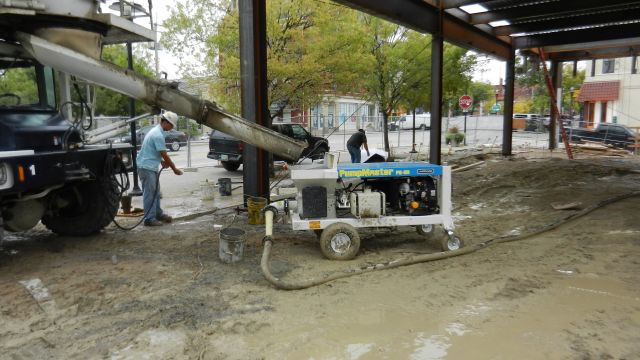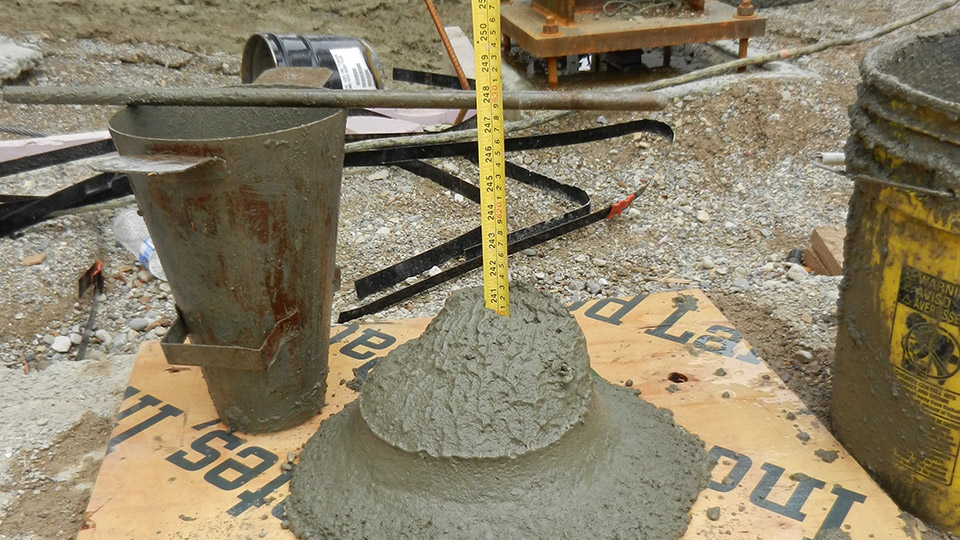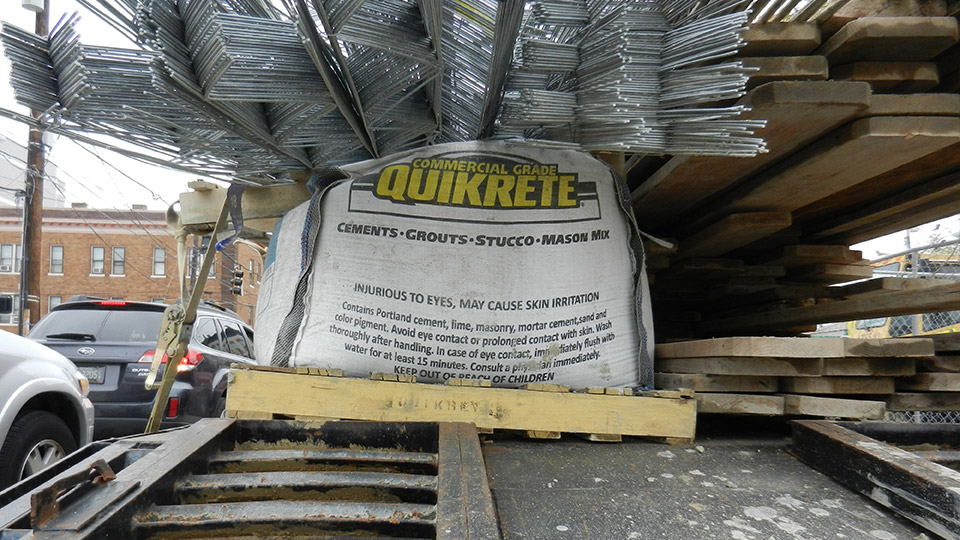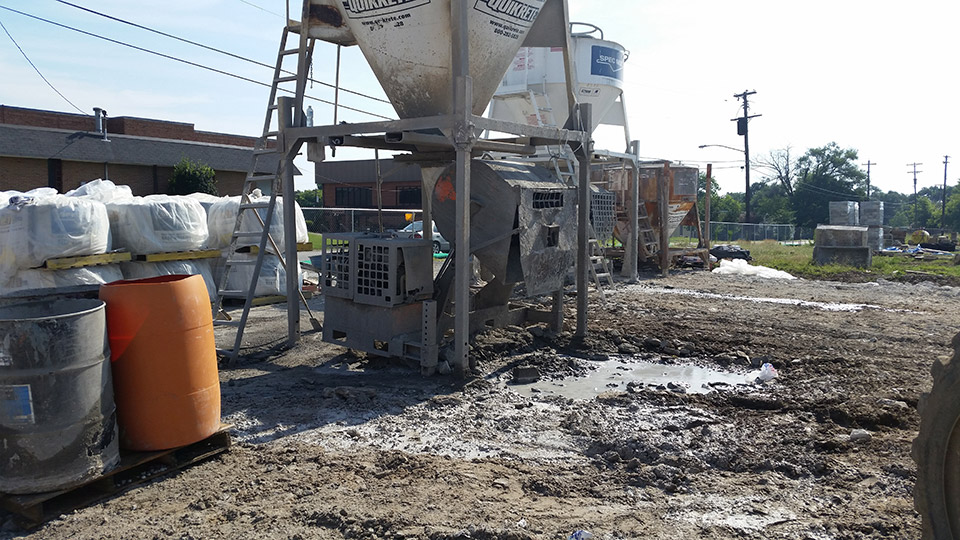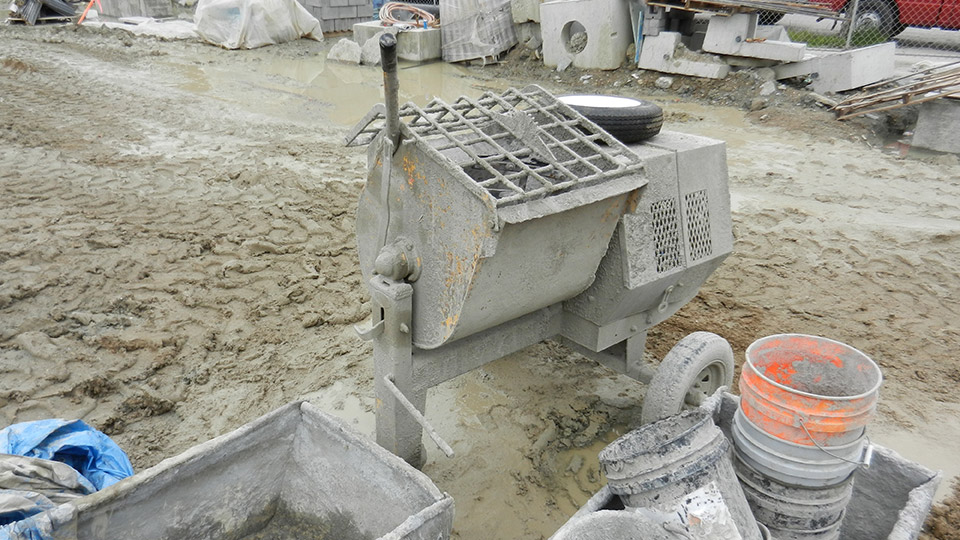Material mix design for masonry grouting
Mixers, pumps and delivery systems
The masonry industry has established guidelines for masonry grout, which allows contractors to produce quality materials and deliver them efficiently to where they are needed on the jobsite. The “Standard Specification for Grout for Masonry” (ASTM C476) is the prevailing specification in the masonry industry. This standard, which is legally recognized in the federal register of the Unites States of America, allows for consistent quality and safety of our masonry structures.
ASTM C476 determines the types of cement, sands, aggregates, water and other additives that the contractor can use in the material mix design and how to proportion these components. In addition to meeting the standard, the contractor ensures that the masonry grout is compatible with any grouting equipment used on the project, such as mortar mixers, delivery systems and grout pumps.
Cement, or cementitious material, is the most important component of the grout for achieving compressive strength. This strength is a measure of the amount of pressure the finished concrete can withstand before failing (ASTM C1019). Cement also serves as the binder for all the other components of the grout. ASTM C476 allows various types of Portland cements, blended cements or limestone products – known as quicklime or hydrated lime.
Fly ash, pozzolans and slag may be used as a cemetitious material, although other conditions may apply to using these components. The grout is classified as either “fine” or “coarse” depending on the aggregate size contained in the mix. Fine grout contains only aggregates passing a 3/8-inch sieve and coarse grout contains only aggregates passing a half-inch sieve. ASTM specifications further determine the requirements of each component in the masonry grout. For example, Portland cement should meet C150, sand should meet C33 and aggregates should meet C404.
Self-consolidating grouts (SSG) do not require mechanical consolidation. These materials contain an additional high range water reducer and are produced with a very high slump to allow the material to flow into all the cavities where it is specified. “Polycarboxylate” high-range water reducers are preferred, while “viscosity-modifying” admixtures may also be used. Aside from creating self-consolidating features, these water reducers may improve compatibility with grouting equipment, reduce cracking from concrete shrinkage and help achieve maximum compressive strength of the mix design. Because of the additional benefits of water reducers, they are often used in both conventional grouts and self-consolidated grouts.
The mix design is the recipe for proportioning materials to produce a masonry grout. ASTM C476 gives two methods for proportioning conventional grouts: “Specified Compressive Strength” and “Conventional Grout Proportions by Volume.” Contractors choosing to specify compressive strength of materials can order from material manufacturers or ready-mix providers. Approved grouts have a 28-day compressive strength of at least 2,000 psi. Contractors order conventional masonry grouts in the range of 2,000 to 4,000 psi from manufacturers who provide 3,000-pouunds bulk bags (super sacks) or 80-pound bags.
These manufacturers provide a written statement showing the compressive strength of the material. Manufacturers estimate the yields and coverage that contractors can expect from bulk bags of masonry grout. Each 3,000-pound bag will yield about one yard of grout and allow contractors to fill about 100 standard blocks at 8 x 8 x 16 inches. Contractors also order masonry grouts by compressive strength from ready-mix companies, who deliver by the cubic yard.
Ready-mix can be custom ordered with certain aggregate sizes and other additives, such as water reducers and air entrainment. As a third option in specifying compressive strength, some manufacturers offer material mix designs that are compatible with their equipment. For example, masonry grout pump manufacturers should have mix designs that are qualified for use in the equipment they supply. These mix designs list the compressive strength and the complete individual ingredients. The typical mixture will show components needed for each cubic yard or cubic meter of grout, including cement, sand, aggregate, water reducer, air entrainment and water content.
| Table 1: Conventional Grout Proportions by Volume | ||||
|---|---|---|---|---|
| Type | Parts by Volume of Portland Cement or Blended Cement | Parts by Volume of Hydrated Lime or Lime Putty | Fine Aggregate (Measured in Damp, Loose Condition) | Coarse Aggregate (Measured in Damp, Loose Condition) |
| Fine grout | 1 | 0-1/10 | 2-1/4–3 times the sum of the volumes of the cementitious materials | ... |
| Coarse grout | 1 | 0-1/10 | 2-1/4–3 times the sum of the volumes of the cementitious materials | 1-2 times the sum of the volumes of the cementitious materials |
Often masonry contractors will have to batch grout onsite, due to timing, budgetary or other reasons. These contractors can use the second of two approved methods for proportioning conventional masonry grouts shown in Standard C476 Table 1, which shows requirements for proportioning by volume. The table specifies proportions of fine and coarse grout by ratio of cement to damp aggregates. Aggregates for fine grout should be in the range of two to three times the volume of cement. Using a standard eight-cubic-foot mixer, contractors can load the equivalent of two bags of material or roughly two cubic feet. This estimation by manufacturers is based on how many 80-pound bags of mortar the mixer can handle without sacrificing quality of the mix or how much weight the mixer’s motor can accommodate. You cannot mix eight cubic feet of material in an eight-cubic-foot mixer.
To create an ASTM C476 fine grout, the contractor could combine half of a cubic foot of cement (half of 94-pound bag) with 1.5 cubic feet of damp, loose sand (120 pounds). To produce a coarse grout according to Table 1, use the ratio of one part cement, two to three parts fine sand and one to two parts coarse sand. Again using the eight-cubic-feet mixer, the contractor could combine half of a cubic foot of cement, one cubic foot of damp, loose sand (80 pounds) and a half of a cubic foot of coarse aggregate – bulk density of crushed stone averages 95 to 105 pounds per cubic foot. ASTM C127 provides a method for determining the weight per cubic foot of coarse aggregates. Add water to either fine or coarse grout to achieve eight- to11-inch slump.
The contractor will decide whether the project warrants ordering materials from manufacturers, hiring ready-mix or batching onsite. In addition to providing super sacks of materials, manufacturers offer a silo storage system for their customers. These silos are frequently used on masonry projects. Silos are often used in tandem with a mortar mixer or even a “wetmix” style continuous mixer that is attached to the silo. Mortar mixers are available in capacities ranging from six to 12 cubic feet with features, such as electric motors, gas motors, various hitch styles, hydraulic dump, manual dump and telescoping legs to allow the mixer to be raised or lowered to meet other equipment.
These telescoping legs offer a major advantage when using the mixer with grouting equipment, ensuring that the dumping height is in line with the material receiving hopper of the pump or material delivery system. Most mortar mixers are compatible with masonry grouts prepared according to C476. Contractors use mortar mixers, which have paddles inside to thoroughly agitate the mix, more often than they use concrete mixers, which use a circulating motion to toss materials around until they are combined. Materials should be combined in the mortar mixer for a minimum of five minutes with sufficient water to achieve eight to 11 in slump.
Contactors order grouts from ready-mix suppliers for large pours. Ready mix allows contractors to order a verified compressive strength material, while maximizing their production rate. Because ready-mix provides such a large batch at a continuous rate, contractors are able to achieve high rates of output when using a grout pump, such as 10 yards or more per hour. By comparison contractors using mortar mixers cannot keep up with the maximum output of a grout pump. Of course, the mortar mixer is still the best option for producing masonry grouts if the contractor has to grout small sections of the structure at various times throughout the project. In these cases, in makes the most sense to produce lower quantities of grout in the mortar mixer and avoid paying for the ready-mix truck.
After materials are proportioned and ready for placement, the contractor will either pour or pump materials to the CMUs. Contractors who use buckets and/or grout scoops have little to no restriction on what type of mix design can be used. The only limit to grouting by buckets is the available labor. If using a material delivery system or a grout pump, contractors can use masonry grouts prepared according to C476 in most cases. Material delivery systems and most masonry grout pumps are designed to handle half-inch aggregates, making them suitable for fine or coarse grouts.
Although the equipment may be compatible with a certain size aggregate, contractors should use acceptable proportions of these aggregates to produce a “pumpable” grout. An aggregate size listing in the equipment specification of a half-inch or ¾ inch does not mean that contractors can use an excessive amount of that aggregate. This can lead to issues such as plugged up material delivery hose or even damage to the equipment. Refer to the manufacturer to be sure the material mix design is compatible with the delivery system. As stated earlier, masonry grout pump manufacturers often provide a pre-approved mix design including compressive strength and proportions of each component. These mix designs can be used to order from ready-mix providers or to batch onsite. Contractors can also use Table 1 when proportioning grouts for material delivery systems or grout pumps. Table 1 does not include proportions of water reducer or air entrainment; however, the project owner may specify or approve these additives. When ordering grouts from manufacturers, contractors should specify compressive strength and aggregate content.
Typical 3000-pound bulk bags will be compatible with most material delivery systems and grout pumps, but these bags have varying compressive strengths and aggregates. It is important to obtain the size and percentage of aggregates in the mix when using a grout pump or delivery system. This can be a challenge given the proprietary nature of the pre-packaged material business. To be safe, order materials offering compressive strengths of 3,000 psi or higher from these manufacturers and use a sieve to test the aggregate size, making sure it is compatible with the grouting equipment.
When using a grout pump to place masonry grouts in CMUs, be sure to prime material hoses before each use. This is done by pumping cement slurry (cement and water mixture) through the total hose length before pumping the masonry grout. Use about five gallons of cement slurry for each 50-foot section of material hose. Material hose diameters should be chosen to accommodate the aggregate size in the mix. As a rule of thumb, hose diameters should be four times the aggregate size. For example, use a minimum two-inch diameter hose with materials containing half-inch aggregates. Flush hoses with water after grouting is complete for the day and thoroughly rinse all grouting equipment, especially material cylinders where grout can be hidden from view. Follow all maintenance recommended by the manufacturer for your mixer, pump or delivery system.
Contractors have specific guidelines to follow when ordering or producing masonry grout. Ordering materials according to their compressive strength is convenient and allows verification that the material meets specifications. Producing grouts by volume measurement is suited to batching onsite and can be done using the standard proportioning Table 1 in C476. Either way, grouting equipment manufacturers offer a range of solutions that are designed to meet the standards for masonry grouting. Contractors can successfully complete grouting projects by meeting standards for masonry grout materials and by choosing the most compatible equipment to deliver grout to the masonry structure.
About the Author
Todd Ferguson is marketing manager for Mesa Industries Inc., parent company of four divisions, Airplaco Equipment Co., Gunite Supply, Mesa Rubber Co. and Mesa Fabrics. For more information, call 513-321-2950 or visit www.airplaco.com.











